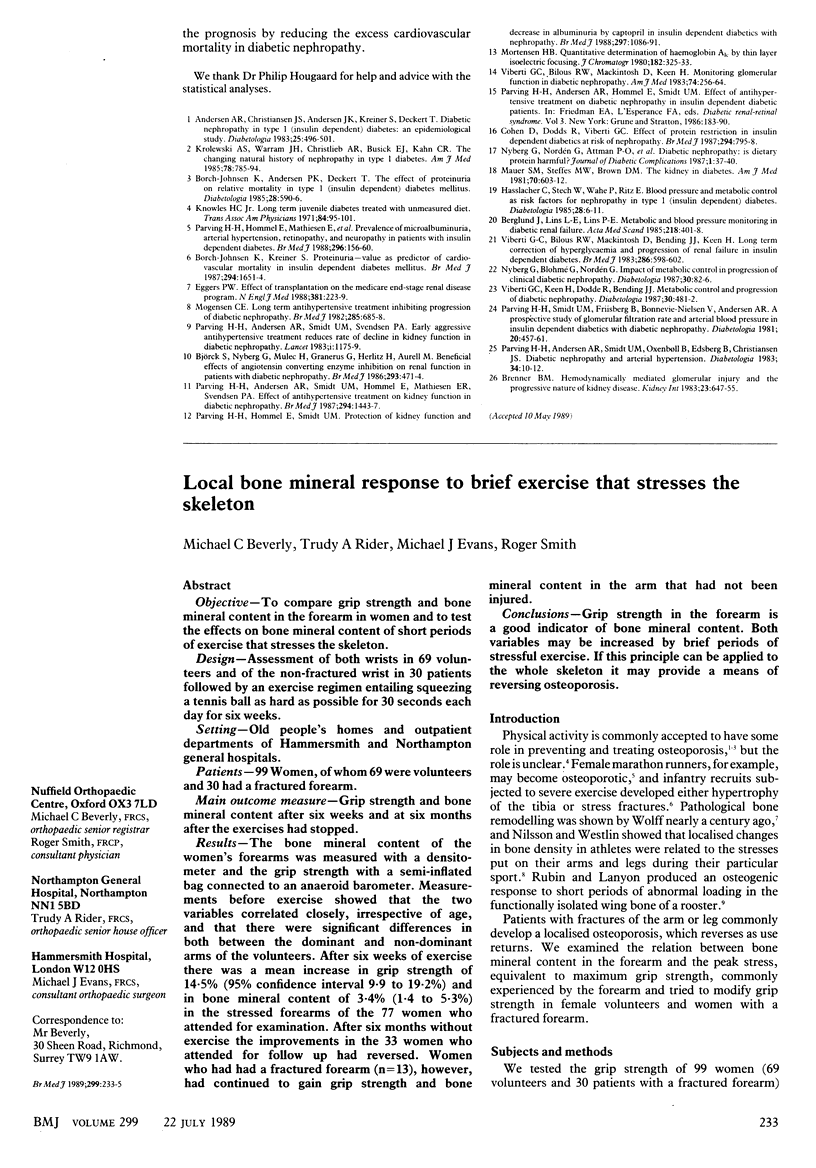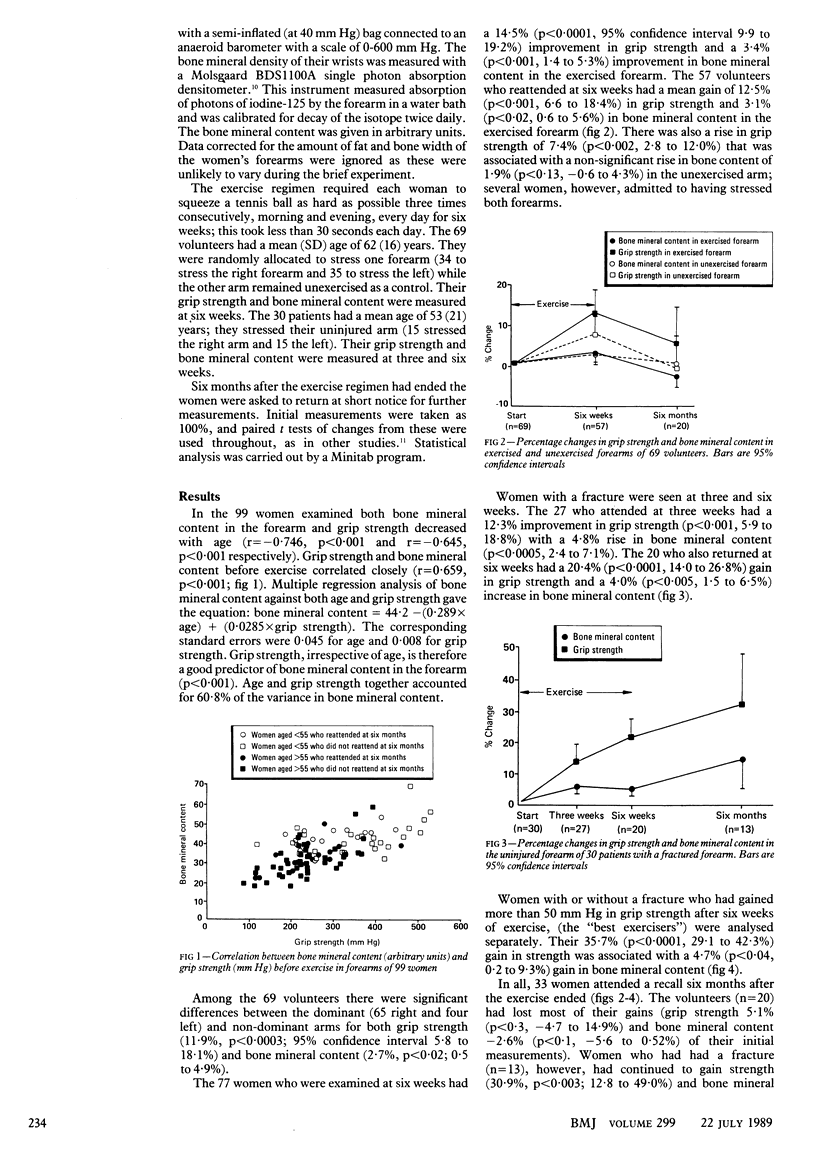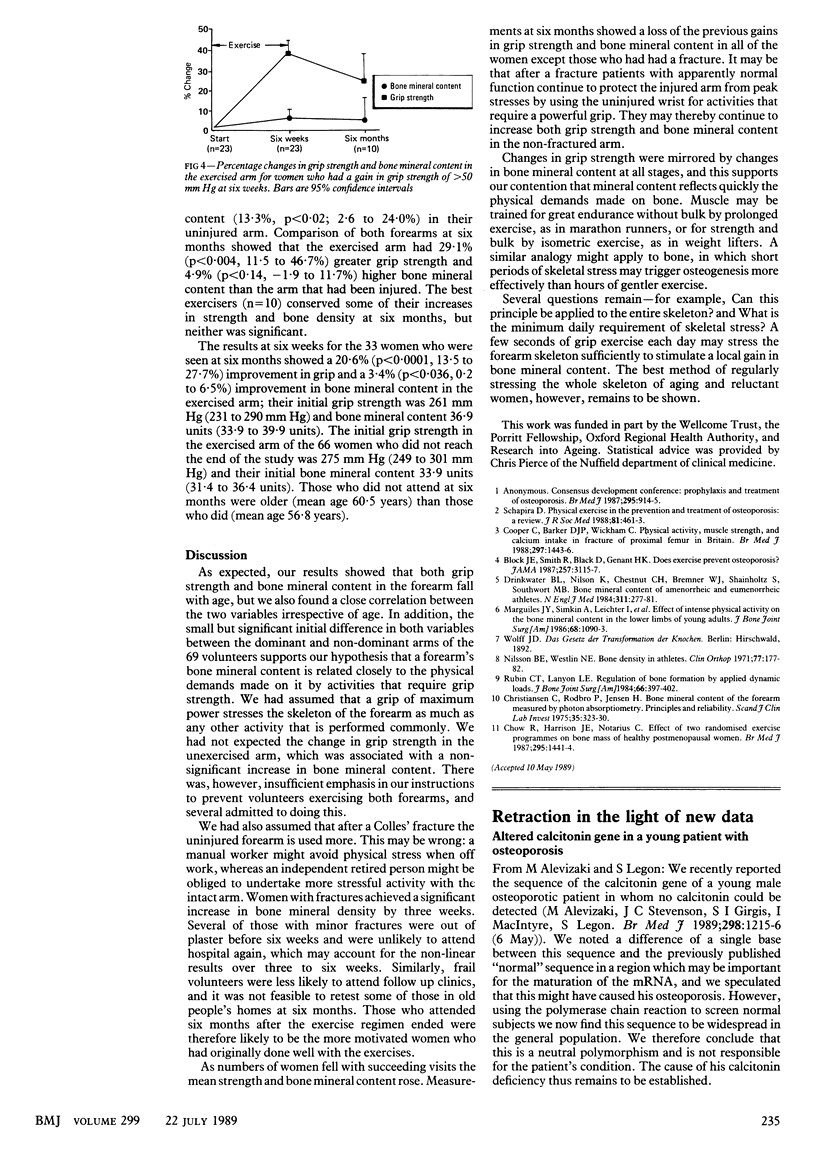Abstract
OBJECTIVE--To compare grip strength and bone mineral content in the forearm in women and to test the effects on bone mineral content of short periods of exercise that stresses the skeleton. DESIGN--Assessment of both wrists in 69 volunteers and of the non-fractured wrist in 30 patients followed by an exercise regimen entailing squeezing a tennis ball as hard as possible for 30 seconds each day for six weeks. SETTING--Old people's homes and outpatient departments of Hammersmith and Northampton general hospitals. PATIENTS--99 Women, of whom 69 were volunteers and 30 had a fractured forearm. MAIN OUTCOME MEASURE--Grip strength and bone mineral content after six weeks and at six months after the exercises had stopped. RESULTS--The bone mineral content of the women's forearms was measured with a densitometer and the grip strength with a semi-inflated bag connected to an anaeroid barometer. Measurements before exercise showed that the two variables correlated closely, irrespective of age, and that there were significant differences in both between the dominant and non-dominant arms of the volunteers. After six weeks of exercise there was a mean increase in grip strength of 14.5% (95% confidence interval 9.9 to 19.2%) and in bone mineral content of 3.4% (1.4 to 5.3%) in the stressed forearms of the 77 women who attended for examination. After six months without exercise the improvements in the 33 women who attended for follow up had reversed. Women who had had a fractured forearm (n = 13), however, had continued to gain grip strength and bone mineral content in the arm that had not been injured. CONCLUSIONS--Grip strength in the forearm is a good indicator of bone mineral content. Both variables may be increased by brief periods of stressful exercise. If this principle can be applied to the whole skeleton it may provide a means of reversing osteoporosis.
Full text
PDF


Selected References
These references are in PubMed. This may not be the complete list of references from this article.
- Block J. E., Smith R., Black D., Genant H. K. Does exercise prevent osteoporosis? JAMA. 1987 Jun 12;257(22):3115–3117. doi: 10.1001/jama.1987.03390220113033. [DOI] [PubMed] [Google Scholar]
- Chow R., Harrison J. E., Notarius C. Effect of two randomised exercise programmes on bone mass of healthy postmenopausal women. Br Med J (Clin Res Ed) 1987 Dec 5;295(6611):1441–1444. doi: 10.1136/bmj.295.6611.1441. [DOI] [PMC free article] [PubMed] [Google Scholar]
- Christiansen C., Rödbro P., Jensen H. Bone mineral content in the forearm measured by photon absorptiometry. Principles and reliability. Scand J Clin Lab Invest. 1975 Jul;35(4):323–330. [PubMed] [Google Scholar]
- Cooper C., Barker D. J., Wickham C. Physical activity, muscle strength, and calcium intake in fracture of the proximal femur in Britain. BMJ. 1988 Dec 3;297(6661):1443–1446. doi: 10.1136/bmj.297.6661.1443. [DOI] [PMC free article] [PubMed] [Google Scholar]
- Drinkwater B. L., Nilson K., Chesnut C. H., 3rd, Bremner W. J., Shainholtz S., Southworth M. B. Bone mineral content of amenorrheic and eumenorrheic athletes. N Engl J Med. 1984 Aug 2;311(5):277–281. doi: 10.1056/NEJM198408023110501. [DOI] [PubMed] [Google Scholar]
- Margulies J. Y., Simkin A., Leichter I., Bivas A., Steinberg R., Giladi M., Stein M., Kashtan H., Milgrom C. Effect of intense physical activity on the bone-mineral content in the lower limbs of young adults. J Bone Joint Surg Am. 1986 Sep;68(7):1090–1093. [PubMed] [Google Scholar]
- Rubin C. T., Lanyon L. E. Regulation of bone formation by applied dynamic loads. J Bone Joint Surg Am. 1984 Mar;66(3):397–402. [PubMed] [Google Scholar]
- Schapira D. Physical exercise in the prevention and treatment of osteoporosis: a review. J R Soc Med. 1988 Aug;81(8):461–463. doi: 10.1177/014107688808100815. [DOI] [PMC free article] [PubMed] [Google Scholar]


